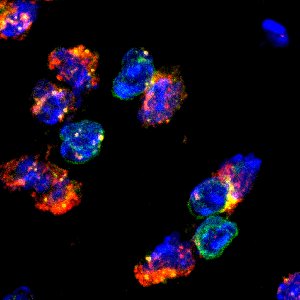LA JOLLA, CA—Follicular helper Tcells (TFH cells), a rare type of immune cell that is essential for inducing a strong and lasting antibody response to viruses and other microbes, have garnered intense interest in recent years but the molecular signals that drive their differentiation had remained unclear. Now, a team of researchers at the La Jolla Institute for Immunology has identified a pair of master regulators that control the fate of TFH cells.
Their finding, published in this week’s online edition of Nature Immunology, holds great promise for improved vaccine design and may lead to new treatments for immune disorders and possibly even cancer. “Almost all licensed human vaccines work on the basis of inducing a long-term, protective antibody response,” says the study’s lead author Shane Crotty, Ph.D., a professor in the Institute’s Division of Vaccine Discovery. “Being able to enhance or increase the frequency of follicular helper T cells may be an excellent approach for better vaccine design.”
Before B cells can launch a full-blown antibody response against invading pathogens they undergo a tightly orchestrated, multi-step maturation process aided by TFH cells. Often compared to a miniaturized Darwinian struggle for survival, this process selectively promotes the proliferation of B cells that produce high-affinity antibodies and weeds out those that produce less potent ones.

“B cells compete for TFH cells to survive,” explains postdoctoral researcher and first author Youn Soo Choi, Ph.D., “Only those B cells that produce highly specific antibodies attract TFH cells and are able to proliferate.” The survivors undergo successive rounds of mutation and selection resulting in better and better antibodies during the course of an immune response.
“TFH cells are essential for the production of most types of antibodies and defects in TFH function or frequency can have dramatic effects,” says Crotty. “It may be particularly important when antibody targets are difficult to recognize and B cells need to explore a bigger mutational landscape. A better understanding of how these cells are produced could really make a difference in how likely it is that your body manages to make good antibodies against an infection.”
In an earlier study, Crotty’s team had identified the BCL6 gene as a crucial mastermind in the differentiation of TFH cells but important pieces of the puzzles had still been missing. A combination of functional genomics and bioinformatics analysis allowed Choi to narrow the list of potential candidates down to a pair of transcription factors, LEF-1 and TCF-1. Transcription factors act as master switching by binding to regulatory regions in the genome, where they modulate gene activity. He then confirmed the importance of LEF-1 and TCF-1 for the differentiation of TFH cells with the help of mice genetically engineered to lack either LEF-1 or TCF-1.
“Their activity pre-programs CD4+ T cells to respond to TFH induction signals,” says Choi. “It seems very likely that any perturbation that results in lower levels of these transcription factors could decrease the likelihood that T cells differentiate into TFH cells.”
As a matter of fact, individual differences in the predilection to make more TFH cells could explain why some individuals produce highly efficient antibodies against HIV, while most individuals are unable to mount a potent immune response. “It is very difficult to create high-affinity antibodies for HIV, which are necessary to neutralize virus,” explains Crotty. “Interestingly, it turns out that those individuals that are able to make broadly neutralizing antibodies against HIV, have unusually elevated levels of highly functional memory TFH cells. We speculate that these people may have a genetic bias to produce a really good TFH response but we haven’t identified it yet.”
The research was supported by the La Jolla Institute for Immunology, the American Cancer Society (RSG-11-161-01-MPC), and the National Institutes of Health (AI105351, AI112579, AI115149, AI119160, AI113806, AI109976, AI063107 and AI072543).
Full citation:
“LEF-1 and TCF-1 orchestrate TFH differentiation by regulating differentiation circuits upstream of the transcriptional repressor Bcl6.” Youn Soo Choi, Jodi A Gullicksrud, Shaojun Xing, Zhouhao Zeng, Qiang Shan, Fengyin Li, Paul E Love, Weiqun Peng, Hai-Hui Xue & Shane Crotty. doi:10.1038/ni.3226
ABOUT LA JOLLA INSTITUTE
La Jolla Institute for Immunology is dedicated to understanding the intricacies and power of the immune system so that we may apply that knowledge to promote human health and prevent a wide range of diseases. Since its founding in 1988 as an independent, nonprofit research organization, the Institute has made numerous advances leading towards its goal: life without disease®.


